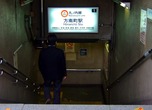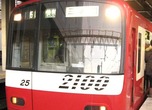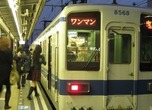Escape on the branch lines #3
Get to know Setagaya ward one stop at a time

Posted: Tue Apr 06 2010
Take any train in Tokyo and you’ll soon find that each one is imbued with its own special atmosphere. Of course, the mood on more mainstream lines like the Yamanote Line is sure to make one feel the full range of energy that the city has in store, however, if you’re looking for something a bit more off-the-beaten-path then some of Tokyo’s branch lines are a great place to start. In Part 1, we hopped aboard the Tobu Kameido Line to get away without going too far, and in Part 2 we got our ticket for the Honancho-shinsen, the kid sibling to one of Tokyo’s most venerated subways. In our final instalment, we’ll be heading through Setagaya ward (aka Setagaya-ku) on the Tokyu Setagaya Line, for a taste of the residential.
Travelling two stops past Shibuya on the busy Tokyo Den-en-toshi commuter line, will bring you to Sangen-jaya station – the starting point for our third and final branch line, the Tokyu Setagaya line. Starting from Sangen-jaya station, the Tokyu Setagaya line stops at 10 stations and takes about 15 minutes to reach Shimo-takaido station, which also connects to the Keio Line. Just as the name says, the Tokyo Setagaya Line operates entirely inside Setagaya ward.
After leaving Sangen-jaya station, situated on the first floor of high-rise Carrot Tower, the next stop along the Tokyu Setagaya Line is Nishi-taishido station. From here, the line crosses Route 318 to reach Wakabayashi station. After passing Shoin-jinja-mae station, close to Setagaya City Hall, the line arrives at Setagaya station, near the site of the annual Boroichi Festival in December and January, pulling into Kamimachi station.
Behind Kamimachi station there is small train depot, where trainspotters can find various 2-car trains painted different colours, each parked as if taking a break. In fact, each of the ten trains operating on the Setagaya line is painted a different colour. It’s even said that school students who commute via this line superstitiously bank on the day’s luck as decided by the colour of the train they board.
At Kamimachi station the lines turns to the north, after which, it stops at Miyanosaka station and then Yamashita station, which is adjacent to Gotokuji station on the Odakyu Line. Nowadays, Setagaya ward is a residential area; however, in the early Showa period, when the line first opened, it was still just rural farmland – especially the area around this particular part of the tracks, which is said to have often suffered droughts and was used mainly to grow wheat (though one is hard-pressed to imagine that now).
On from Yamashita station, the line pauses at Matsubara station before it takes a sharp curve to once again head west, just before pulling into its final stop, Shimotakaido station, which also connects to the Keio Line. The Tokyu Setagaya Line was originally a branch line of the former Tamagawa line, which originally ran between Futako-tamagawa and Shibuya – a function that the more modern Den-en-toshi Line now performs. Since it was first opened 85 years ago, the Tokyu Setagaya Line is one branch line has certainly seen its fair share of change.
Tags:
Tweets
- About Us |
- Work for Time Out |
- Send us info |
- Advertising |
- Mobile edition |
- Terms & Conditions |
- Privacy policy |
- Contact Us
Copyright © 2014 Time Out Tokyo














Add your comment